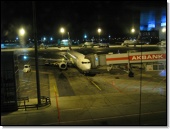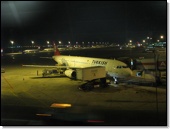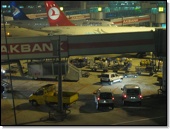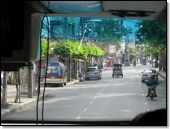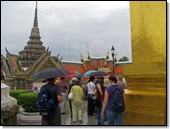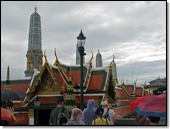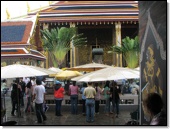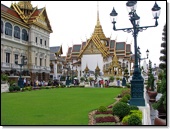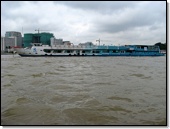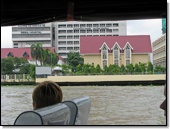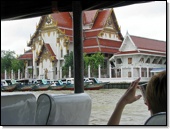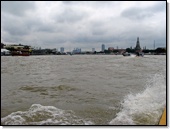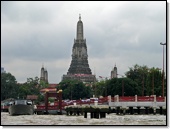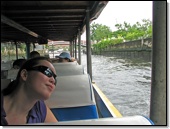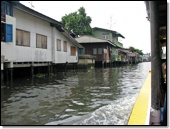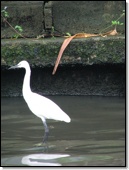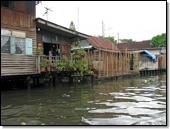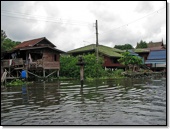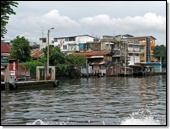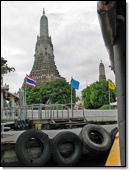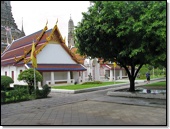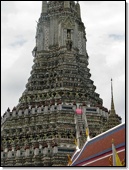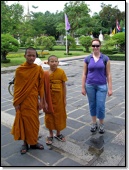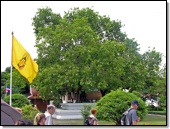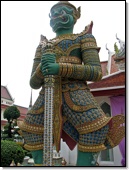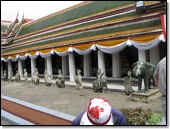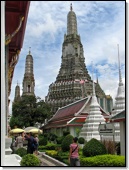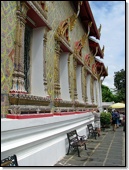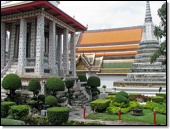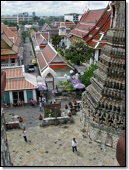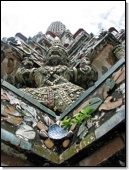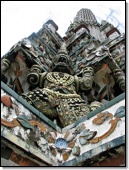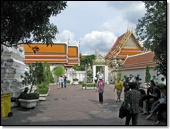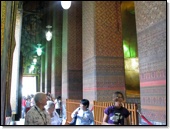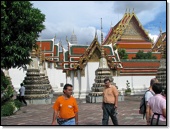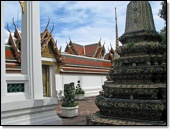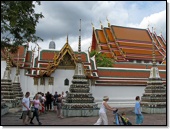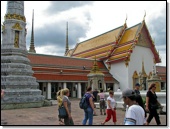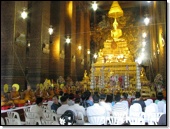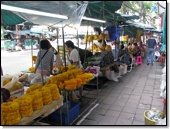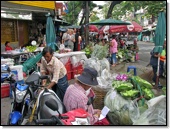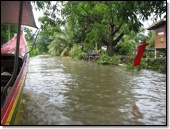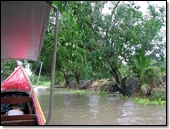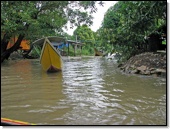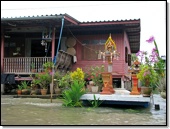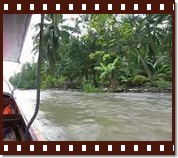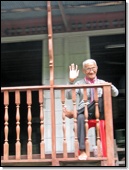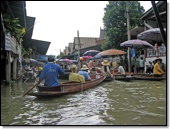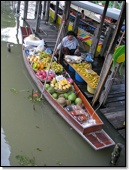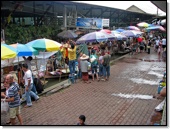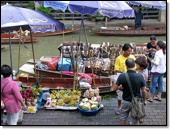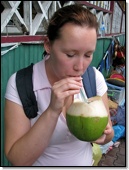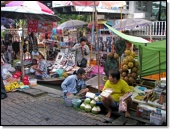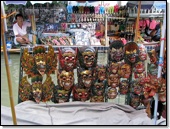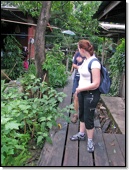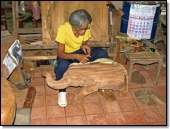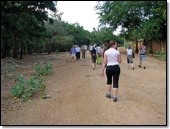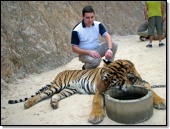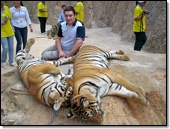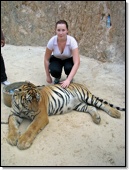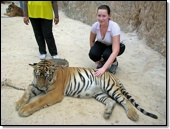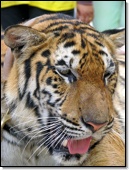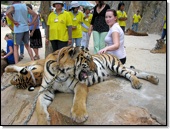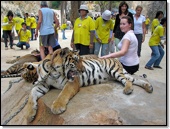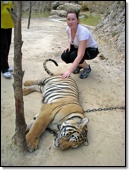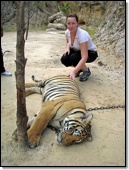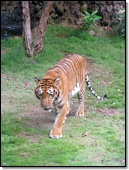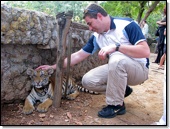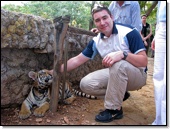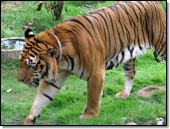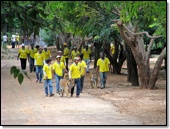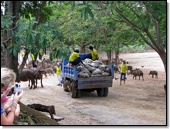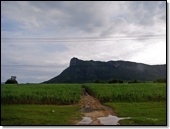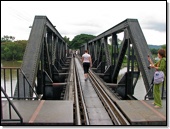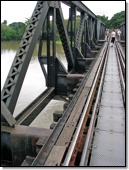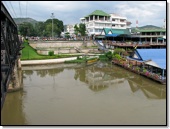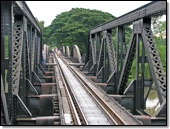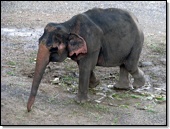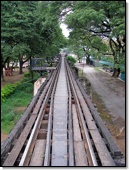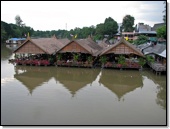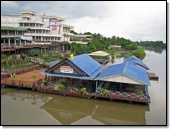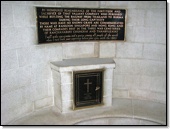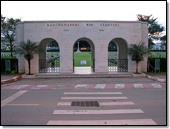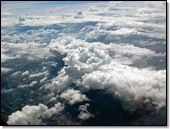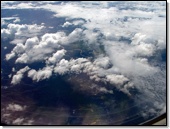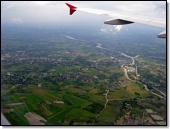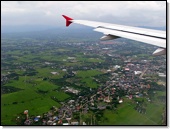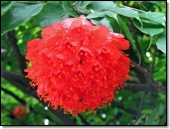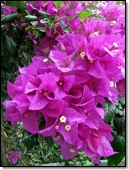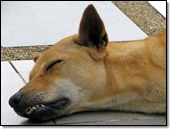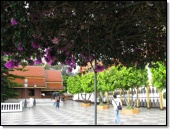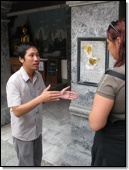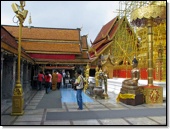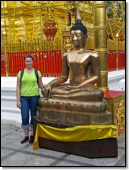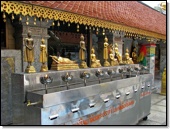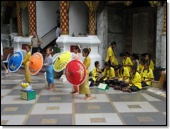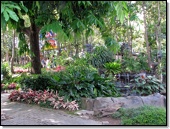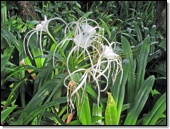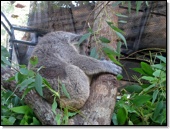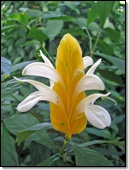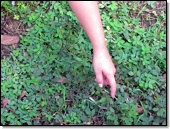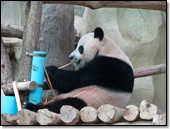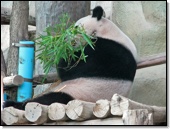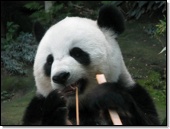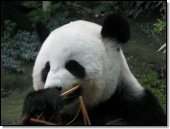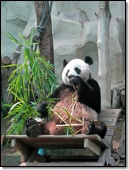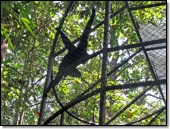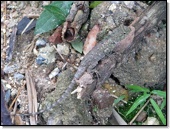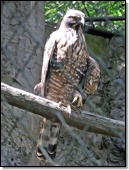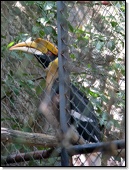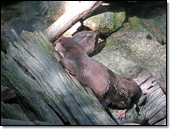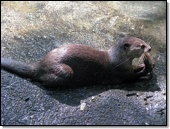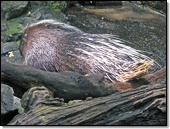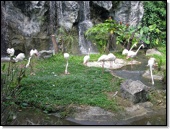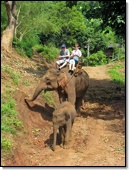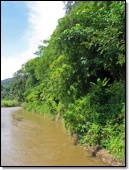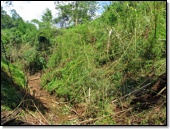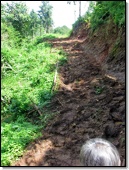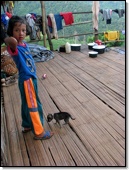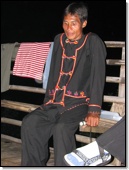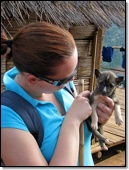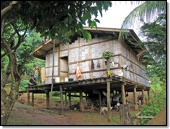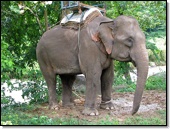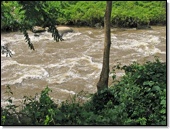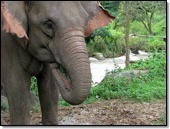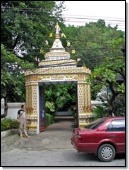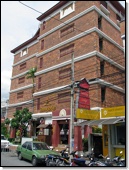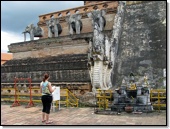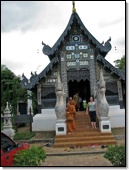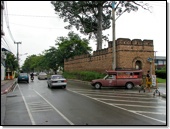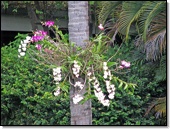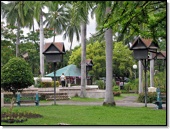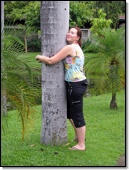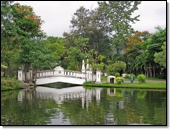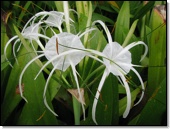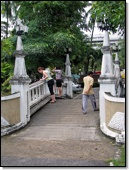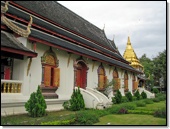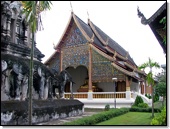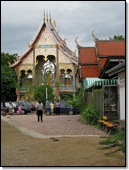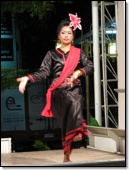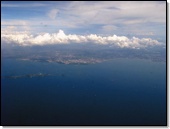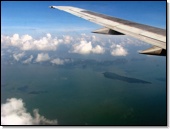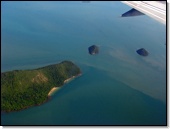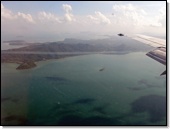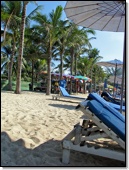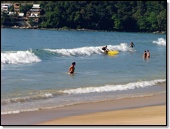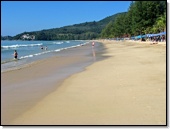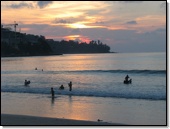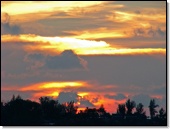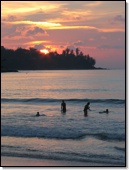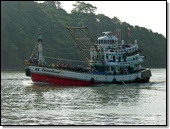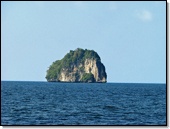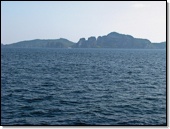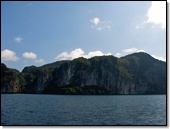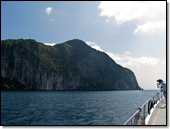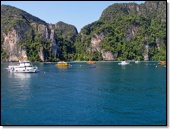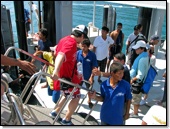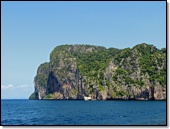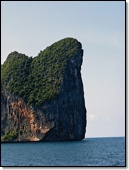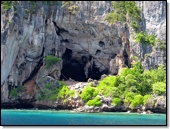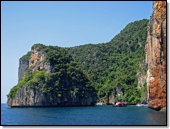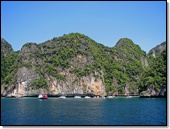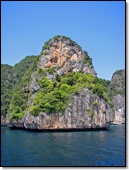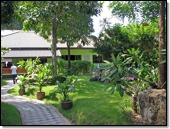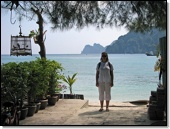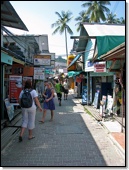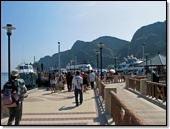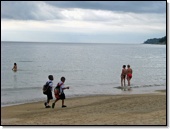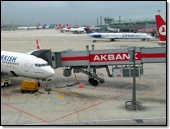 |
Sightseeing Thailand
Bangkok, Kanchanaburi, Chang Mai, Phuket
|
 |
October-November 2008
Organized by Odpelji.se, Slovenia
Duration: 16 days
Group size: 14
Tour guide: Damjana Račič

Ljubljana - Istanbul - Bangkok
Starting at Ljubljana airport on the way to Bangkok, out first stop was Istanbul Ataturk
International Airport, Turkey. Getting there in the afternoon, we had a few hours to kill
while waiting for a connecting night fligh to Thailand's capital.
We landed in Bangkok early in the afternoon local time. We were soaking in out first impressions
of Thailand while driving from the airport to Bangkok downtown. We settled in the Twin Towers
Hotel, had a few hours to rest, then gathered in the evening to check out the night life.
 |
 |
 |
 |
 |
| Driving from the Bangkok International Airport on the new highway to the hotel |
 |
 |
 |
 |
 |
| The room was nice |
Performance at the hotel lobby |
First evening in Bangkok, we visited a local street market. Lots of small shops to put our bargaining skills to the test,
street vendors with delicious chicken kebabs.
 |
 |
 |
 |
 |
|
Shortly after arriving, it started raining heavily |
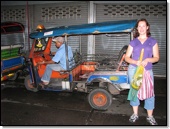 |
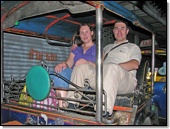 |
 |
 |
| Sonja and myself took a tuk-tuk back to the hotel for the first time |
Video: Tuk-tuk ride
44.1 MB, 3:44 |
Bangkok
The second day in Bangkok, and we had some serious sightseeing to do in the city. There is a lot to see in
Bangkok, and we had a full day ahead. The weather was still acting up in the morning, starting with heavy
clouds turning in light presistent drizzle in the first few hours. Last evening's downpour still left plenty
of water up there.
We started by visiting Wat Phra Kaew, Temple of
the Emerald Buddha. This is the main and most visited temple in Bangkok, located on the ground of the Royal
Palace, and is regarded the most sacred Buddhist temple in Thailand. The is a home to a 66-centimetre image
of the meditating Buddha carved out of jade. Seated on a gilt altar and surrounded by other effigies, it is
so precious no one else but the Thai King is allowed to touch it, and even then only to change its robes
at the start of the summer, rainy, and winter seasons.
 |
 |
 |
 |
 |
| Entrance is the most photographed spot in Thailand |
 |
 |
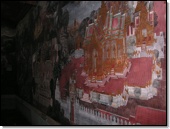 |
 |
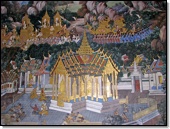 |
|
All around the complex is a long wall with very detailed paintings, depicting
the life of the Buddha and steps to enlightenment. |
 |
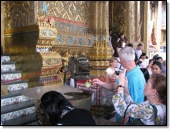 |
 |
 |
 |
|
Crowd at the enterance to the Chapel of the Emerald Buddha. |
The Emerald Buddha |
 |
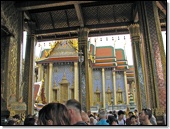 |
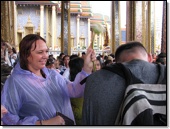 |
 |
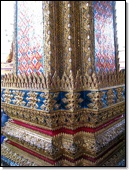 |
Each season it is
dressed differently |
|
Dipping lotus buds in
water for luck. |
Extreme mosaic details on the buildings |
 |
 |
 |
 |
 |
Phra Mondop is a library built in Thai style by Rama I, bookcases containing the Tripitaka (sacred
Buddhist manuscripts), human- and dragon-headed nagas (snakes), and statues of Chakri kings. |
 |
 |
 |
 |
 |
| Wat Phra Kaew is located at the Grand Palace |
 |
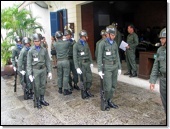 |
 |
| Changing of the guards at the Grand Palace |
Leaving Wat Phra Kaew, we walked to the nearby Chao Praya river and boarded a long-tail boat to take us driving
for an hour or so through Bangkok's Canals, the Khlongs.
Khlongs are often found on most major rivers in Thailand, forming communities living on the riverbanks. There can be seen
some of the incredible contrasts in Bangkok, get an insight into how people live on the riverbank and see the city from
water level. It's a very different world from the commercial centre.
 |
 |
 |
 |
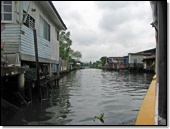 |
|
Video: Tour on Khlongs 1
6.03 MB, 0:29 |
 |
 |
 |
 |
 |
|
At this temple, fish in the khlong are considered sacred and are well used to feeding. |
 |
 |
 |
 |
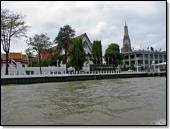 |
Video: Tour on Khlongs 2
5.49 MB, 0:27 |
|
Back on the Chao Praya |
Royal Navy headquarters,
Wat Arun rising behind |
Disembarking on the pier right next to the temple, there was Wat Arun, Temple of the Dawn,
one of the Bangkok's oldest temples. The most attractive structure of Wat Arun is the center Khmer-style 79-meter high pagoda or Phra Prang decorated with
sea shells and a mosaic of multi-colored Chinese porcelain. The outer four corners are Prangs which hold statues of Phra Phai (god of the wind).
Buildings in the compound of Wat Arun house the monks, and some of them are used as small museum and library.
Returning to the east bank of the Chao Praya river taking the Chao Phraya River Express boat, we went for a short walk
to one of the small street vendors for a well deserved lunch. Waiting for us not far away was the third major Bangkok's
temple, Wat Pho, The Temple of the Reclining Buddha.
Wat Pho is the largest Wat in Bangkok, as well as the oldest, dating in 200 years before Bangkok became Thailand's capital.
It is mainly famous for the huge Reclining Buddha statue it houses. The highly impressive gold plated reclining Buddha is
46 meters long and 15 meters high, and is designed to illustrate the passing of the Buddha into nirvana. The feet and the
eyes are engraved with mother-of-pearl decoration, and the feet also show the 108 auspicious characteristics of the true
Buddha.
 |
 |
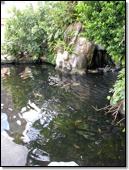 |
 |
 |
| A detail of Buddha's feet |
Offerings |
On the way back to the hotel in the afternoon, we have passed a small fruit market, a chance to experience and try
some exotic Asian fruit you rarely have the chance to see at home.
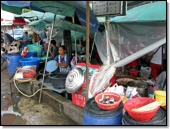 |
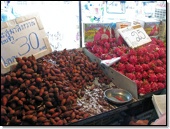 |
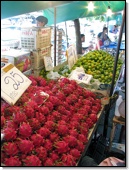 |
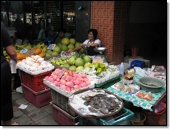 |
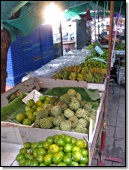 |
| Exotic fruits on stands - dragon fruit, papaya, jackfruit, pomelo, baby bananas, star fruit... The most exotic of them all, apples. |
Driving to Kanchanaburi
The next day, we are driving to Kanchanaburi, a small town 150 km west of
Bangkok and bordering Myanmar (Burma), the location of the famous Bridge on the River Kwai. On route and back will will be stopping at
several other locations, including the Maeklong Market built in the middle of the railway, the Tiger Temple, and one of the most beautiful
Thai floating markets Dumnoen Saduak, Ratchaburi Province. It's another long day ahead.
 |
 |
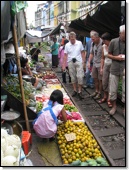 |
 |
 |
Leaving Bangkok
downtown |
The first short stop is at the Maeklong Market. It's a market like any other, but with a touch... |
 |
 |
 |
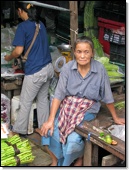 |
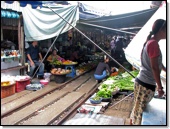 |
| ...it's build right on an operating railway, with train passing through several times a day. |
When train approaches... |
 |
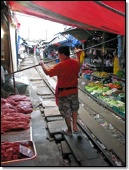 |
 |
 |
 |
| ...they pack away their stands within minute, clearing the way. |
Video: Train approaches
12.4 MB, 1:03 |
Video: Train passing
6.34 MB, 0:27 |
The next stop on route to the floating market is at the Coconut Sugar Farm by the road, also featuring an orchid farm.
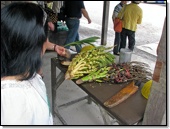 |
 |
 |
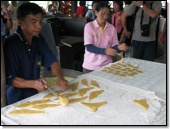 |
 |
| This is how they make palm sugar from coconut flowers, and we got to taste some. |
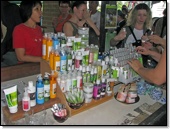 |
 |
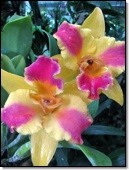 |
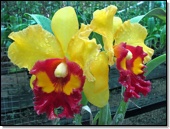 |
 |
Palm oil is used
in cosmetics |
Orchids were just asking to be photographed up close. |
Finally we are getting to the most famous floating market in Bangkok, Dumnoen Saduak Floating Market.
According to history, around 1866 King Rama IV ordered that a 32 kms long canal be dug at Damnoen Saduak. This canal would connect
the Mae Klong River with the Tacheen River, providing a transportation route for goods to Bangkok. Most people live densely along
both sides of the canal from one end of the canal to another. The majority are agriculturists, grow several different kinds of
fruit and vegetable, for examples oranges, grapes, papayas, cabbages, bean, onion and etc.
As it is floating, you get there by taking a boat. We boarded a long speedboat some distance away, and first got to enjoy the local scenery
while driving to the market through the many canals.
 |
 |
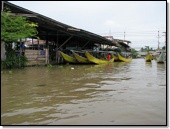 |
 |
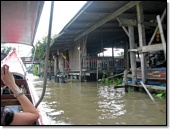 |
| Long speedboats transporting tourists to the market |
Midday past already, we were heading to the Tiger Temple. On the way, we made a quick stop at one of the
larger teakwood carving shops by the road.
Tiger Temple, or Wat Pha Luang Ta Bua, is a Buddhist temple in
Western Thailand which keeps numerous animals, among them several tigers that can be petted by visitors. According to the abbot
and others associated with the temple, in 1999 the temple received the first tiger cub, it had been found by villagers. Over time.
several tiger cubs were given to the temple, typically when the mothers had been killed by poachers. As of 2007, over 21 cubs have
been born at the temple and the total number of tigers is about 12 adult tigers and 4 cubs.
Tigers are fed with cooked chichen to avoid giving the tigers a taste for blood. The temple is making considerable income by
charging visitors for photo opportunities with the tigers.
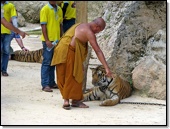 |
 |
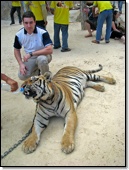 |
 |
 |
 |
| Monks and volunteers are taking care of tigers |
Robert trying not to look like a cooked chicken |
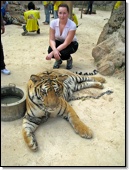 |
 |
 |
 |
 |
|
Pigs and piglets running around the sanctuary |
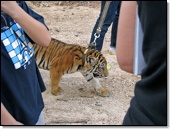 |
 |
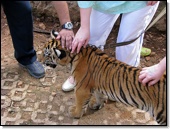 |
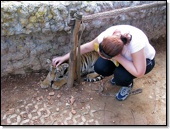 |
 |
| There are several small tiger cubs brought out and available for petting |
Late in the afternoon, in dying light, me just made it to the final destination of the day, the town of Kanchanaburi with the
(in)famous Bridge on the river Kwai. It gained notoriety during World War II when the Japanese
needed a railway connecting Bangkok with Rangoon in preparation for an invasion of India. Work started on what has become
known as ‘The Death Railway’ in October 1942 and was completed in December 1943. In that short space of time more than 13,000
Commonwealth, Dutch and American prisoners of war lost their lives. It was also a main target for the allied forces, as
the Japanese wanted to use it to transport there supplies, and the railway was therefore bombed several times.
A novel and one of the best Hollywood movies of all times The Bridge on the
River Kwai (1957) both tell the story of building this bridge.
 |
 |
 |
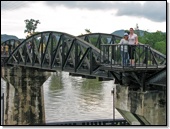 |
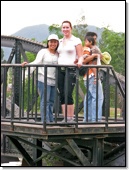 |
|
A well known silhuette of the Kwai bridge in the evening light |
Sonja and Jen,
our local guide |
 |
 |
 |
 |
 |
|
You can cross the bridge, and look at it up close |
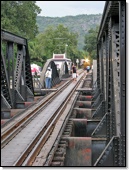 |
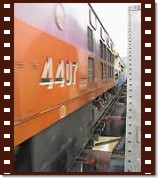 |
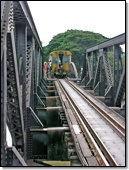 |
 |
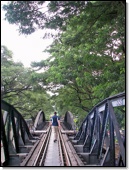 |
 |
| The bridge is still in use, a train crosses it about once an hour |
 |
 |
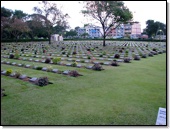 |
 |
 |
|
Kanchanaburi War Cemetary, with more than 6900 prisoners of war victims associated with the Burma railway,
mostly British and Dutch |
We returned to Bangkok in dark of the evening. Altough tired, this was the last night we would have in Bangkok,
and we went out to explore some more. We visited Patpong, the notorious red-light district, with plenty of
barganing opportunities at street stands and night bazaar, did some souveneer shopping, had a nice late
dinner at a small restaurant nearby...
Bangkok - Chang Mai
We were leaving humid Bangkok, and flying to the north of Thailand, looking forward to a more moderate climate.
Chang Mai is the second largest city in Thailand,
although a lot smaller than metropolitan Bangkok. In the heat of the summer in Bangkok, it's a popular refuge of
many wealthier Thai. Chang Mai has over 800 years of history, city centre feauturing a defensive wall and a moat.
It's located among some of the highest mountains in the country, and has a beautiful nature readily accessible all
around it.
 |
 |
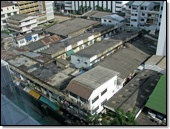 |
 |
 |
| Leaving Bangkok, the view from our hotel room in the morning |
 |
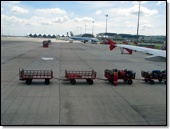 |
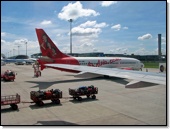 |
 |
 |
| Our baggage gets loaded |
Taking off in Bangkok |
 |
 |
 |
 |
 |
| It was a beatiful day for flying, as we got good seats for taking photos all the way to Chang Mai |
 |
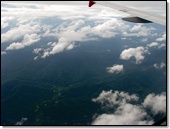 |
 |
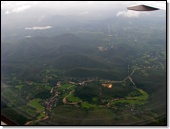 |
 |
|
Descening to Chang Mai, vegetation gets thicker and greener
|
We settled in the Pornping Tower Hotel, located just next to the
Kalare Night Bazaar, and in walking distance from city center. We checked out the night bazaar in the evening.
Map of Chang Mai
 |
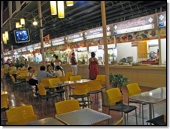 |
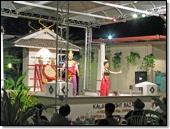 |
 |
 |
| Kalare Food Court, fast foof Thai style |
Entertainment in the evenings
|
 |
 |
 |
| Kalare Food Court, fast foof Thai style |
Sonja bargaining
for old coins |
Chang Mai
The next morning we started the day by driving to Doi Suthep, a mountain about 15 kilometers from Chiang Mai,
with on it Wat Prathat Doi Suthep, a Holy Buddhist Temple.
The temple of Wat Phra That Doi Suthep is one of the most revered temples in Chiang Mai, as well as in Thailand.
According to the legend of its founding legend, a Buddha relic was placed on the back of a sacred white elephant,
which was allowed to roam whereever it wanted. The elephant climbed to the top of Suthep Mountain, trumpeted three
times, turned around three times, knelt down and died. This was taken as a sign that this was the spot where the
relic wanted to be, so King Ku Na built the original of the chedi on Doi Suthep at the end of 14th century.
Map of Wat Prathat Doi Suthep
 |
 |
 |
 |
 |
There are about 300 steps to climb, with two dragons
on the side all the way |
An old jackfruit tree |
 |
 |
 |
 |
 |
| The white elephant |
|
Good luck will come to the visitor who strikes the series of bells |
 |
 |
 |
 |
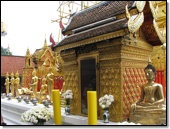 |
|
Golden painted pagoda (chedi), one of the
most sacred in all Thailand, is ongoing restoration |
 |
 |
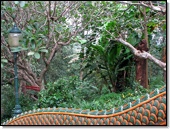 |
 |
 |
| Descending the dragon stairs back down to the road |
Returning late in the morning from the Doi Suthep back towards Chang Mai is the Chang Mai Zoo.
We made a quick stop, just for a couple of hours, far too little to properly explore enjoy all the animals, just enough for a quick tour through
the most attractive areas. They are quite proud of their panda, thanks to Chang Mai's Chinese sister city Kunming, and you can also find koalas,
monkeys, tigers, a rino, penguins, losts of birds and lizards,...
The next stop after the zoo was one of Chang Mai's most famous tourist shopping destinations, the Silk Village.
As the name states, this is a series of handicraft shops and manufactoring plants producing an original Thai silk, commonly in a
traditional fashion on a loom.
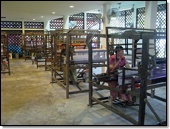 |
 |
 |
 |
| Traditional looms |
Silk worms, remains |
These are fresher |
 |
 |
 |
 |
 |
|
Worms making silk cocoons. They get boiled with worms still inside, so the delicate silk thread isn't cut. |
 |
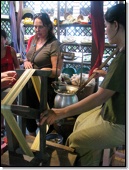 |
 |
 |
 |
| Extracting thread from cocoon |
Weaving fabric, interleaving silk thread dyed in different colors. |
 |
 |
 |
 |
 |
| Pottery shop, using different kinds of finish, like handpainting and sticking golden leaves |
 |
 |
 |
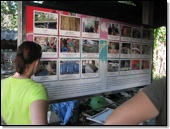 |
 |
|
Gems extravaganza |
How paper is made |
 |
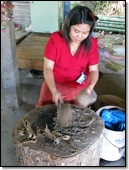 |
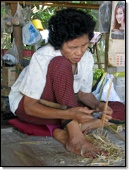 |
 |
 |
| They also make beutiful hand-made umbrellas from split and bound wood and paper |
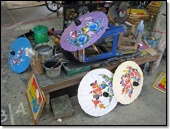 |
 |
 |
 |
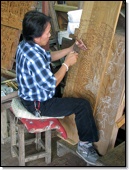 |
|
Wood carving, breathtaking as always |
Further down the road, already in late afternoon, was the last destination for the day,
San Kamphaeng Hot Springs.
Famous for hot geysers, mineral baths and gardens that make a pleasant setting for relaxation.
 |
 |
 |
 |
| A beautiful green park, perfect for slow walking |
 |
 |
 |
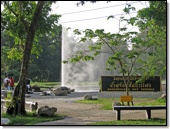 |
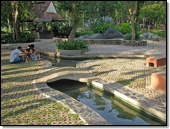 |
| The main hot geyser. They have eggs ready if you want to boil them. |
 |
 |
 |
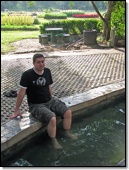 |
 |
|
Soaking tired feet in a warm, slighly sulphury water |
 |
 |
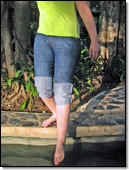 |
 |
 |
|
We also took a swim in the swimming pool with warm,
milky spa water |
Trekking
One of the highlights of visiting Thailand came next, a two-days trekking trip in the hills and mountains of the
northern Thailand, bordering Mjanmar (Burma). We were looking forward to walking in clean air and unspoiled nature,
experience the real jungle from up close and spend the night in one the the hilltribe villages, among Lahu people.
In addition, we have other activities to look forward to during the trek, including elephant riding, and rafting.
Leaving Chang Mai in the morning, we had one and a half hour drive to the north ahead, to the trek starting location.
On the way, we have stopped on a local market for our guides to shop for needed supplies.
 |
 |
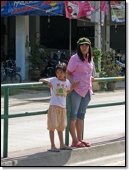 |
 |
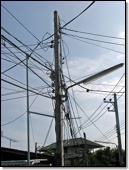 |
| Crammed in a small, open truck, I was taking photos from the back as we went |
 |
 |
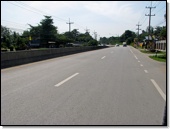 |
 |
| On the Thai roads, leaving Chang Mai and driving north |
A quick stop |
 |
 |
 |
 |
 |
|
A small local market where we stopped for supplies |
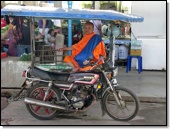 |
 |
 |
 |
 |
| A monk on a Honda |
|
A family comes shopping |
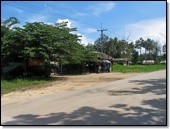 |
 |
 |
 |
 |
| Soon we turned off the main road, the ride became bumpier, and countryside greener |
We arrived at a small camp base to have lunch, before we hit on the trek. We were a bit early though, and the plan was
adjusted quickly - elephant riding comes first. We split in pairs, and each got assigned an elephant with a guide. They
have special ramps prepared, so it's easy to get on and off an elephant, although you are sitting quite high of the ground.
Having climbed down from the elephants, we had our lunch and started to walk. The plan was to hike for about 4 hours,
passing a waterfall, and the destination for the day was a Lahu hillltribe village, where we would have dinner, chat with
the locals, and spend the night in one of the guesthouses they have in the village.
 |
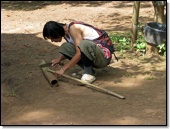 |
 |
| Having lunch |
Local guide made us
bamboo walking sticks |
...and off we went |
 |
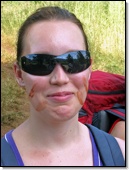 |
 |
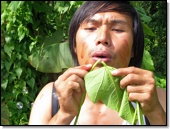 |
 |
| Rice fields |
Guide is showing us local plants on the way, one has reddish milk and is
used as a dye, the other is soapish inside, and you can blow bubbles |
Banana tree |
 |
 |
 |
 |
 |
| Entering the forest, the first part of the trek is fairly level |
A big, poisonus spider |
 |
 |
 |
 |
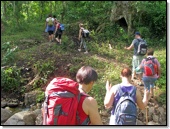 |
| There were lots of streams to cross, and walking was generally quite pleasant |
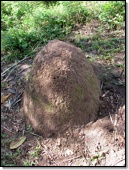 |
 |
 |
 |
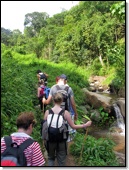 |
| Termites |
It's early afternoon, not too hot, but quite humid in the forest... |
 |
 |
 |
 |
 |
| The first stop after two hours by the waterfall... |
...just to get us ready for the last, exhausting part |
 |
 |
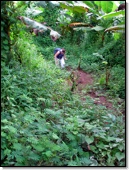 |
 |
 |
| The path turns steeply uphill as we enter the hills, and we were biting our knees for the next two hours |
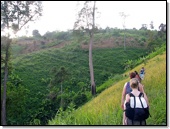 |
 |
 |
 |
 |
| Finally, a welcome sight of wooden houses, at the last stretch of steep fields to cross |
 |
 |
 |
 |
 |
|
Entering the village |
Playful children |
 |
 |
 |
 |
 |
|
A view on the village and surrounding hills from the guesthouse's patio |
 |
 |
 |
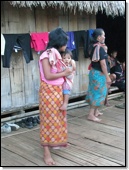 |
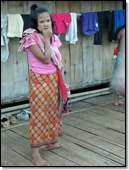 |
| Having had a shower and change of clothes, long walk is quickly forgotten |
Most of the village visits us, and we
get a thai massage |
 |
 |
 |
 |
 |
| They prepare a delicious local style dinner for us, followed by mingling by candlelights on the patio outside late in the night |
We woke up to a calm morning, got ourself cleaned up and had a nice breakfast, prepared by our friendly guide. The plan for
the day was to leave the village, descend the hill on the other side down to the river, where we would go rafting before
return to Chang Mai in late afternoon.
 |
 |
 |
 |
 |
|
The sun is slowly lighting up the countryside |
 |
 |
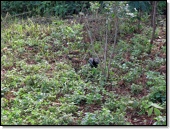 |
 |
 |
| Preparing breakfast |
|
Toast, eggs,
and fresh ananas |
 |
 |
 |
 |
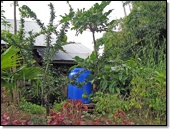 |
|
Little miss in
nice shoes |
School, abandonded for
the lack of teachers |
Over there is Myanmar |
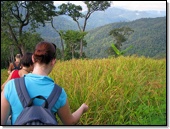 |
 |
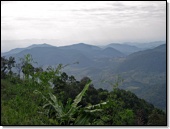 |
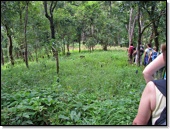 |
 |
|
A nice path through the forest... |
 |
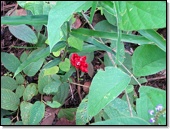 |
 |
 |
 |
| ...quickly gets steeper, wet, and slippery |
 |
 |
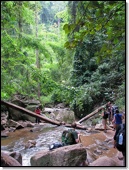 |
 |
 |
|
Some two hours later, we finally descend to the valley and reach the waterfall |
 |
 |
 |
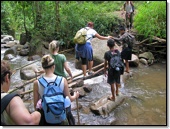 |
 |
| Time for a shower and welcome rest |
Golden sand |
We follow the river, crossing it in many different ways |
 |
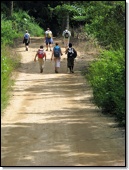 |
 |
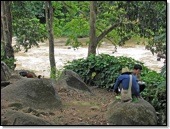 |
 |
| The last half an hour was easier to walk, and we ended our trekking trip in the rafting base camp |
While we were waiting to go rafting, some have dozed off in peace of a comfortabe shadow. The same location was
also a starting point of elephant trekking, and there were quite a few elephants standing around.
 |
 |
 |
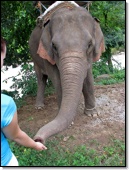 |
 |
| Elephants welcoming small treats |
 |
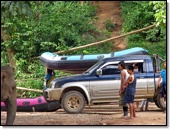 |
Now that's a big...
elephant |
Our boats are here,
time to go |
There are no photos of the rafting itself, for obvious reasons. It was fun, wet, and not too difficult. After a quick
shower and change of sogging clothes we had a lunch, then climbed back on the small truck for the drive home.
 |
 |
 |
 |
 |
| For the final part we were on bamboo rafts |
Lunch time |
Our young guides
from the trekking |
 |
 |
 |
 |
 |
| On the way back to Chang Mai, we have stopped at a local village for a quick walk-through |
 |
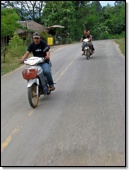 |
| Driving back to Chang Mai |
Free day in Chang Mai
The day after the trekking was a free day, as well as the last day in Chang Mai. Some used to rest and recuperate while most
went out on individual trips, or just enjoyed sightseening the pleasant city. Sonja and myself chose to get to know Chang Mai
better, spending most of the day just walking around.
Map of Chang Mai
 |
 |
 |
 |
 |
Kalare Food Court,
deserted in the morning |
Walking west towards the center of the city |
Crossing a small khlong |
 |
 |
 |
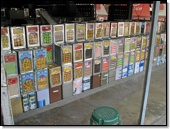 |
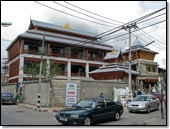 |
| Reaching the ditch protecting the old Chang Mai |
We walked up to the Wat Chedi Luang, a historic Buddhist temple in the
center of the city. The temple features one of the largest buildings of the 14th century at the time, and was partically collapsed
by an earthquake 100 years later. Until then, the temple used to house the Emerald Buddha, we have seen in Bangkok's main temple,
Wat Phra Kaew.
 |
 |
 |
|
Pavilion housing a
reclining buddha statue |
We continued to the south-west, passing smaller temples. At that time it started raining heavily, and we took a refuge in
a small bar with internet available, having some icecream while waiting, and checking out what's new back at home.
In the south-western corner of the old city walls is the Nong Buak Hat, a very well-kept little public park which is great for tai-chi or
reading a book on the pleasant lawns.
 |
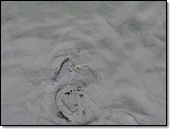 |
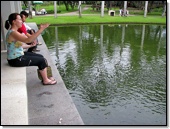 |
 |
 |
| You can buy some fishfood at the entrance, and feed the fat fish in the pond |
Stepping outside of the park, we waved down a songthaew, a small red truck, and took a 10 minutes ride to the northern part of
the old city, to the Wat Chiang Man temple.
In the evening we are back on the Kalare Night Bazaar, packed with boutiques, stalls, cheap restaurants, and a beer garden
featuring nightly performances of traditional Thai dances. It's the last night in Chang Mai, and the last chance for some
shopping and bargaining before we proceed to Phuket.
 |
 |
 |
 |
| Night bazaar entrance |
There are some really amazing artists to be found there, the best
photo realistic drawing we've ever seen |
 |
 |
 |
 |
 |
| Every evening at the food court, live entartainment presents traditional and more modern Thai dancing. |
Flying to Phuket
The next morning we left Northern Thailand, said goodbye to a pleasant Chang Mai, and flew back to Bangkok to proceed
to the Thai south, the island of Phuket. Phuket is the largest island in Thailand, also known as the 'Pearl of the South'.
Because of beautiful beaches and sea, renouned nightlife and nice weather, Phuket becomes one of the top places in Thailand
that travelers choose to go. This island was also among the hardest struck locations of the December 2004 tsunami disaster,
suffering 279 casualties and massive infrastructure damage, consequences still visible to this date.
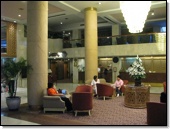 |
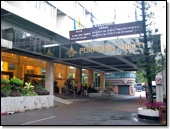 |
 |
 |
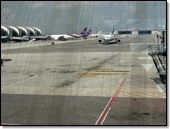 |
| Leaving the Pornping hotel |
We flew back to Bangkok, and waited there for a connecting flight to the sea side |
The last part of the Thailand trip was meant for relaxation on the beach, and Phuket is perfect for just that. Long sandy
beaches, beach-side activities, nice hotels and plenty of trips and excursions available. You can do as much, or as little as
you want. Were were staying at the Kamala Beach Hotel, on the Kamala
beach. Quite a nice place, with a two pools and the sea right next to it.
The second day on Phuket was reserved for a whole-day trip to the Phi Phi Island.
A shuttle service picked as up at the hotel in the morning, and we drove across the island to the Phuket Town, the largest
city on Phuket. A boat would take us sightseeing by many islands, amazing beaches, and with frequent stops for snorkling and
swimming. After lunch and some free time for activities on Phi Phi we would be returned to Phuket and back to our hotel.
The last several days on Phuket were free to enjoy the beach, sunbathe by hotel's pool, slurping cocktails, and relax as
we please. Sonja did have an unpleasant encounter with a jelly fish that turned out to be a nasty one, putting her in bed
sick with a fever for two days. Luckily, it passed before we had to depart Thailand, and we still managed to squeeze in
renting two jet skis for some fast driving while exploring nearby bays from the sea side...
The time has come to leave Phuket, Thailand, and return home. Again, it was to be a long jurney, changing three flights, meaning
a lot of airport time. First we flew back to Bangkok, catch a night flight to Istanbul, and back to the Ljubljana Airport.
 |
 |
 |
 |
| Taking the last few photos of the island while driving to the Phuket airport |
A long wait in Bangkok |
 |
 |
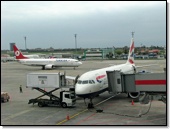 |
 |
 |
| Nothing much better to do in Istanbul either, counting hours to flight back to Ljubljana and photographing planes outside |

